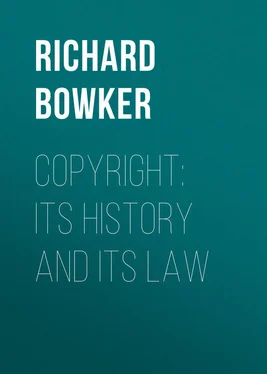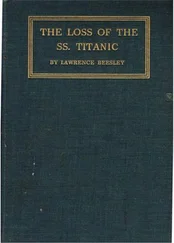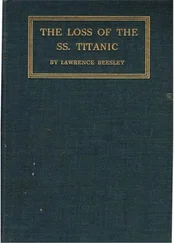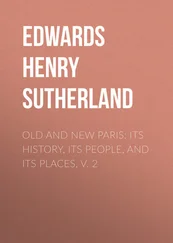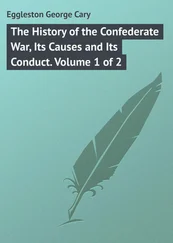Richard Bowker - Copyright - Its History and Its Law
Здесь есть возможность читать онлайн «Richard Bowker - Copyright - Its History and Its Law» — ознакомительный отрывок электронной книги совершенно бесплатно, а после прочтения отрывка купить полную версию. В некоторых случаях можно слушать аудио, скачать через торрент в формате fb2 и присутствует краткое содержание. ISBN: , Жанр: foreign_antique, foreign_prose, Историческая проза, на английском языке. Описание произведения, (предисловие) а так же отзывы посетителей доступны на портале библиотеки ЛибКат.
- Название:Copyright: Its History and Its Law
- Автор:
- Жанр:
- Год:неизвестен
- ISBN:http://www.gutenberg.org/ebooks/39502
- Рейтинг книги:3 / 5. Голосов: 1
-
Избранное:Добавить в избранное
- Отзывы:
-
Ваша оценка:
- 60
- 1
- 2
- 3
- 4
- 5
Copyright: Its History and Its Law: краткое содержание, описание и аннотация
Предлагаем к чтению аннотацию, описание, краткое содержание или предисловие (зависит от того, что написал сам автор книги «Copyright: Its History and Its Law»). Если вы не нашли необходимую информацию о книге — напишите в комментариях, мы постараемся отыскать её.
Copyright: Its History and Its Law — читать онлайн ознакомительный отрывок
Ниже представлен текст книги, разбитый по страницам. Система сохранения места последней прочитанной страницы, позволяет с удобством читать онлайн бесплатно книгу «Copyright: Its History and Its Law», без необходимости каждый раз заново искать на чём Вы остановились. Поставьте закладку, и сможете в любой момент перейти на страницу, на которой закончили чтение.
Интервал:
Закладка:
The Georgian period
Meantime, during the Georgian period, there had been much incidental copyright legislation. The provision in the statute of Anne for the limitation of prices was repealed by the act of 1739, which also continued the prohibition of the importation of foreign reprints, further continued in later acts or customs regulations from time to time, until these were disposed of by the statute law revision act of 1867. Copyright had been extended to engravings and prints by successive acts of 1734-5 (8 George II, c. 13), 1766-7 (7 George III, c. 38) and 1777 (17 George III, c. 57); to designs for linen and cotton printing by acts of 1787, 1789 and 1794; to sculpture by acts of 1798 and 1814 (54 George III, c. 56). A private copyright act of 1734 granted to Samuel Buckley, a citizen and stationer of London, sole liberty of printing an improved edition of the histories of Thuanus, and the engravings act of 1767 contained a similar special provision for the widow of Hogarth. In 1814 also, copyright in books was extended to twenty-eight years and the remainder of life, and the author was relieved from delivering the eleven library copies then required, except on demand. The university copyright act of 1775 (15 George III, c. 53), above-mentioned, and the other acts given with specific citation above, still constitute, in certain unrepealed provisions, a part of the English law, although others of their provisions and other laws were repealed by later copyright acts or by the statute law revision act of 1861 or that of 1867.
Legislation under William IV
In the reign of William IV the dramatic copyright act of 1833 (3 William IV, c. 15) became, and in part remains, the basis of copyright in drama. The lectures copyright act of 1835 (5 & 6 William IV, c. 65) for the first time covered that field. In 1836 the prints and engravings copyright (Ireland) act (6 & 7 William IV, c. 59) extended protection to those classes in that country, and another copyright act (6 & 7 William IV, c. 110) reduced the number of library copies required to five. These laws also remain in force, in unrepealed provisions, as a part of British copyright law.
The Victorian act of 1842
In 1841, under the leadership of Serjeant Talfourd, author of "Ion" and other dramatic works, a new copyright bill was presented to the House of Commons, in the preparation of which George Palmer Putnam, the American publisher, then resident in London, had been consulted. It provided for compulsory registration and extended the term to life and thirty years. The bill attracted little attention and met with no opposition until the second reading, when Lord Macaulay, a bachelor, interested in fame rather than profit to an author or his descendants, attacked the bill and "the great debate" ensued. Macaulay offered a bill limiting copyright to the life of the author, but finally assented to a compromise, by which the term was made forty-two years or the life of the author and seven years, whichever the longer. The resulting copyright act of 1842 (5 & 6 Victoria, c. 45) presented a new code of copyright, covering the ground of previous laws, but not in terms repealing them. As a result, provisions not specifically repealed or superseded remained in force, and the act of 1842, though serving since as the basic act, has had to be construed with the previous acts in view. The bill practically preserved, however, the restrictions of the statute of Anne. The term of forty-two years or life and seven years is applied to articles in periodicals, but the right in these reverts to the author after twenty-eight years. The Judicial Committee of the Privy Council may authorize the publication of a work which after the author's death the proprietor of the copyright refuses to republish.
Protection of designs
In the same year, 1842, there was passed also a copyright in designs act, covering designs for articles of manufacture, consolidating previous laws on this specific subject from 1787 to 1839 (two bills in this last year having extended protection to printing designs for woolen and other fabrics and to articles of manufacture generally), and providing for a registrar for such designs, – in which act the careless use of the word "ornamenting" seemed so to limit the scope that an amendatory act was passed in 1843.
Subsequent acts
An international copyright act, introduced in the first year of the Victorian reign, had been passed in 1838, to protect foreign books reprinted in England, but it proved inadequate and was repealed by the subsequent act of 1844 (7 & 8 Victoria, c. 12), providing more comprehensively for international copyright, on the basis of registration and deposit in London. The colonial copyright act of 1847 (10 & 11 Victoria, c. 95) authorized copyright legislation by any colony, subject to the approval of the Crown, and the suspension for such colony of the prohibition of foreign reprints, which act is therefore often cited as the foreign reprints act. An act of 1850 further covered designs and provided for their provisional registration, and one in 1851 protected exhibits at the international exhibition of that year in London. A third international copyright act was passed in 1852 (15 & 16 Victoria, c. 12) covering translations and including an authorization of a special treaty with France. The fine arts copyright act of 1862 (25 & 26 Victoria, c. 68) extended copyright to paintings, drawings, and photographs, hitherto unprotected, for life and seven years. A fourth international copyright act of 1875 (38 & 39 Victoria, c. 12) protected foreign dramatic works from imitation or adaptation on the English stage, which had been specifically permitted by the previous law, and in the same year "The Canada copyright act" (38 & 39 Victoria, c. 53) gave effect to a Canadian parliament act respecting copyright reprints.
The Royal Commission report of 1878
"The law of England, as to copyright," says the report of the Royal Copyright Commission, in a blue-book of 1878, "consists partly of the provisions of fourteen Acts of Parliament, which relate in whole or in part to different branches of the subject, and partly of common law principles, nowhere stated in any definite or authoritative way, but implied in a considerable number of reported cases scattered over the law reports." The digest, by Sir James Stephen, appended to this report, is presented by the Commission as "a correct statement of the law as it stands." This digest is one of the most valuable contributions to the literature of copyright, but the frequency with which such phrases occur as "it is probable, but not certain," "it is uncertain," "probably," "it seems," shows the state of the law, "wholly destitute of any sort of arrangement, incomplete, often obscure," as says the report itself. The digest is accompanied, in parallel columns, with alterations suggested by the Commission, and it is much to be regretted that their work failed to reach the expected result of an act of Parliament. The evidence taken by the Commission forms a second blue-book, also of great value.
This report and digest covered legislation through 1875, inclusive of the Canada act. They seem also to have regarded, though the act is not specified in the schedule, the consolidated customs act of 1876 (39 & 40 Victoria, c. 36), which incidentally contained the provisions for the prohibition of the importation of copyright books.
Later legislation
Despite the recommendations of the Commission and several later endeavors to pass a comprehensive copyright act, – of which the most important was Lord Monkswell's bill introduced into Parliament on behalf of the British Society of Authors, November 16, 1890, and given in full with an analysis by Walter Besant in George Haven Putnam's "Question of copyright" – later legislation in England has been confined practically to two topics, international copyright and the vexed question of musical compositions.
Читать дальшеИнтервал:
Закладка:
Похожие книги на «Copyright: Its History and Its Law»
Представляем Вашему вниманию похожие книги на «Copyright: Its History and Its Law» списком для выбора. Мы отобрали схожую по названию и смыслу литературу в надежде предоставить читателям больше вариантов отыскать новые, интересные, ещё непрочитанные произведения.
Обсуждение, отзывы о книге «Copyright: Its History and Its Law» и просто собственные мнения читателей. Оставьте ваши комментарии, напишите, что Вы думаете о произведении, его смысле или главных героях. Укажите что конкретно понравилось, а что нет, и почему Вы так считаете.
